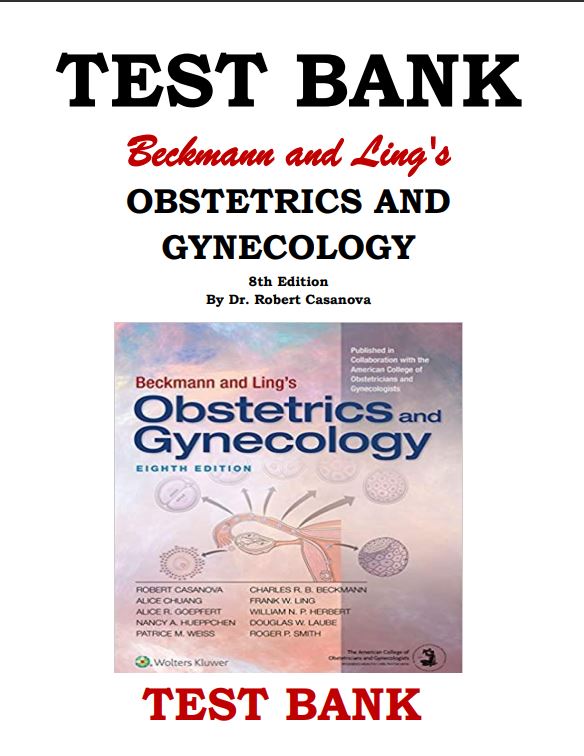Beckmann and Ling's OBSTETRICS AND GYNECOLOGY 8th Edition TEST BANK
Beckmann and Ling's OBSTETRICS AND GYNECOLOGY 8th Edition TEST BANK
Couldn't load pickup availability
Beckmann and Ling's Obstetrics and Gynecology Edition 8th edition Test Bank
Chapter 1: Women’s Health Examination and Women’s Health CareManagement
1:
Elevating the head of the examining table approximately 30 degreesfacilitates
a. The observation of the patient's responses
b. The ability of the patient to comfortably look around to distract her from the examination c:
c. The contraction of the abdominal wall muscle groups, making the examination easier
d. Comfortable blood pressure measurement
e. The physician not being distracted by eye contact with the patient
2:
Which of the following uterine positions is most associated with dyspareunia?
a. Midposition, retroflexed
b. Retroverted, anteflexed
c. Anteverted, anteflexed
d. Retroverted, retroflexed
e. Midpostion, anteflexed
3:
Inquiry concerning adult and child history of sexual abuse should be included in the sexual history
a. if time permits
b. in visits where there are suspicious physical findings but not otherwise
c. in visits where sufficient time is allotted
d. in all new patient visits
e. in visits where a specific indication is noted
4:
Peau d'orange change in the breast is associated with
a. edema of the lymphatics
b. jaundice
c. too vigorous breastfeeding
d. overly tight undergarments
e. galactorrhea
5:
Which kind ofspeculum is often most suitable for examination of the nulliparous patient?
a. Morgan's speculum
b. Endoscopic speculum
c. Ling speculum
d. Graves speculum
e. Pederson speculum
6:
Which uterine configuration is most difficult to assessfor size,shape, configuration, and mobility?
a. Midposition
b. Anteverted
c. There is no difference in difficulty
d. Retroverted
7:
Which type of speculum is most appropriate for the examination of a parous menstrual woman?
a. Ling speculum
b. Graves speculum
c. Pederson speculum
d. Endoscopic speculum
e. Morgan's speculum
8:
Menopause is defined as the cessation of menses for greater than
a. 9 Months
b. 36 Months
c. 12 Months
d. 18 Months
e. 24 Months
a:
all the time
b:
almost never
c:
about one-half of the time
d:
about thee-quarters/most of the time
9:
In a woman describing sufficiently frequent sexual encounters, infertility typically is described as a
failure to conceive after
a:
3 months
b:
9 months
c:
12 months
d:
18 months
e:
6 months
10:
During bimanual examination of the adnexa in normal premenopausal women, the ovaries are palpable
Share

